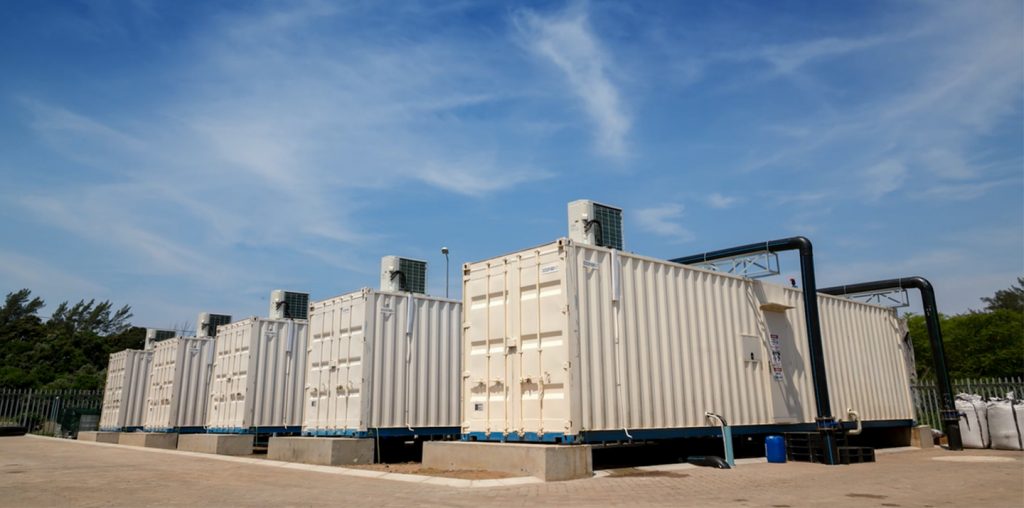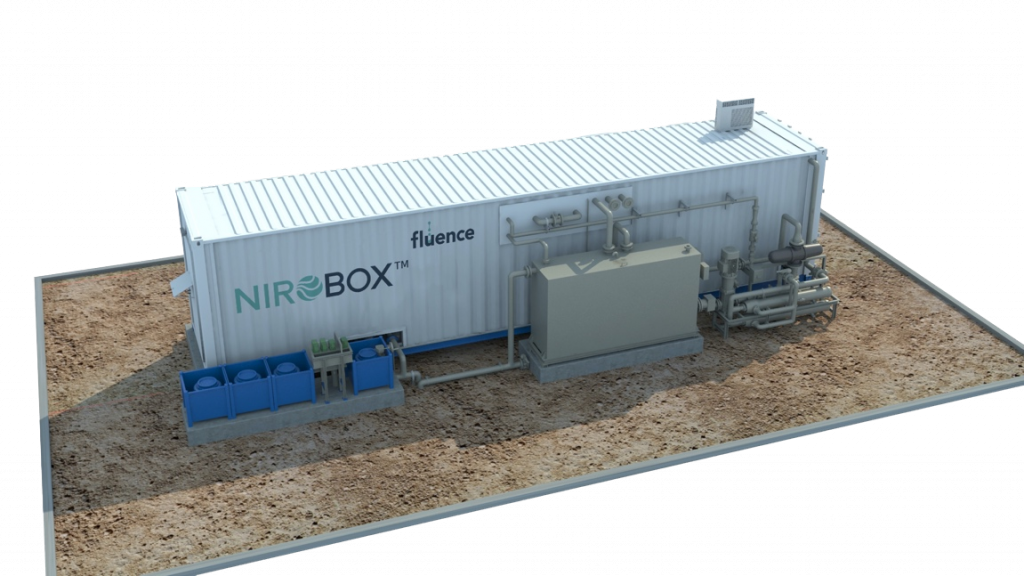What Is Desalination?

Fluence’s NIROBOX™ seawater and brackish water desalination plants are ideal for decentralized treatment in even the most remote locations.
As demand for fresh water increases, communities look to the sea and to previously unusable brackish sources
As demand for fresh water increases, communities look to the sea and to previously unusable brackish sources water scarcity is causing a host of geopolitical and humanitarian problems. To help meet the demand, a process known as desalination, or desalinization, can be used to create fresh water from both seawater and brackish water, which is less saline than seawater but too salty for consumption.
The U.S. Geological Survey defines saline water by the following concentrations of salt, expressed in parts per million:
- Fresh water: Less than 1,000 ppm
- Slightly saline water: From 1,000 ppm to 3,000 ppm
- Moderately saline water: From 3,000 ppm to 10,000 ppm
- Moderately saline water: From 3,000 ppm to 10,000 ppm
- Ocean water: About 35,000 ppm
Desalination Around the World
The size of the global water desalination equipment market is projected to increase to 25.7 billion by 2027, driven mostly by growing consumption and depletion of fresh water in the Mideast and Africa. Nations that rely heavily on desalination include Israel, Saudi Arabia, Kuwait, the United Arab Emirates, Qatar, Bahrain, Libya, and Algeria. The United States is one of the largest users of desalinated water among industrialized countries, with facilities mostly in California and Florida. One of the largest emerging desalination markets is Latin America, which began to attract attention in 2012 with demand for reverse osmosis and nanofiltration membranes in the mining and oil exploration sectors.
Desalination Methods
People have been purifying salt water for ages. Most systems have duplicated nature's process for creating rain. One of the earliest forms of desalination used human-controlled evaporation, or steam distillation, to remove salt from water. The distillation process also reduces other drinking water contaminants.
Types of distillation desalination include multiple-stage flash evaporation, which was considered the most feasible large-scale desalination technology in the 1960s; multiple-effect distillation; and vapor compression. The three processes use different methods of heating seawater and condensing steam. Although vapor compression is more efficient than the other processes, all these methods use significant amounts of energy.
In recent years, these evaporative processes have been overtaken by reverse-osmosis desalination, a process that filters pressurized salt water through membranes, using less energy than distillation. Advances in membrane technology have made the process even more efficient and economical, putting desalination within reach for more people around the world.
Technological Advances in Desalination
In the past decade, seawater reverse osmosis (SWRO) desalination was revolutionized in Israel when initial filtration through a granular volcanic Tuff medium superseded the rapid sand filtration process that had been the standard.
One concern associated with reverse osmosis technology is biofouling, the accumulation of microorganisms, plants, or algae on wet surfaces. Graeme K. Pearce, principal at Membrane Consultancy Associates, an independent consulting firm, told WaterWorld that biofouling "increases both energy use and chemical cleaning frequency, giving a higher carbon footprint and creating a waste sludge for disposal." Tuff medium filtration, which is a novel chemical-free process, eliminates most of the biofouling problems that had plagued SWRO while slashing chemical use in cleaning.
Desalination now supplies an unprecedented 80% of Israel's fresh water.
At Fluence, we're keeping our eyes on the future and harnessing the most advanced technologies available today. Our customizable seawater desalination units feature energy recovery systems that use pressure exchangers or turbine pumps to reduce energy requirements by as much as 40%.
Desalination and Politics
With fresh water a universal need for survival, availability of the precious resource can have political repercussions. According to the U.S. Geological Survey:
It is very likely that the water issue will be considered, like fossil energy resources, to be one of the determining factors of world stability.
Indeed, the water-energy-food (WEF) security nexus in recent years has been universally acknowledged as fundamental in geopolitics. But countries vulnerable to WEF insecurity often don't have the resources for regional-scale desalination plants. Those located in remote areas can also face construction difficulties. And, territorial issues may make regional construction, sharing of resources, and construction of trans-boundary pipelines challenging.
Decentralization
In such cases, decentralized desalination offers a number of advantages. Decentralization means placing treatment units directly where it's needed instead of connecting to a large, centralized water treatment plant. The number of units can be scaled up or down as needed, delivering water independence while avoiding the risk of overbuilding capacity. Containerized packaging of state-of-the-art water treatment technology has brought decentralized desalination off the drawing board and into the market.
Smart Packaged Desalination

A recent Fluence project, featuring a total of 12 NIROBOX SW units, will desalinate 12,000 m³/d on the Mediterranean coast of Egypt.
Traditional, large desalination plants require significant investment and space. To provide drinking water after natural disasters or in locations where it's not feasible to build huge plants, researchers, including scientists at MIT, have worked on energy-efficient, low-cost solutions.
A solution gaining market traction due to its small footprint and affordability is Fluence's NIROBOX™. This small, prepackaged decentralized water treatment system can be installed quickly and requires approximately 40% less CAPEX investment than typical custom desalination plants. NIROBOX's plug-and-play packaging expedites delivery and commissioning.
Within two months of ordering, one 40-foot container can supply fresh water for 10,000 people. A single NIROBOX™ can produce as much as 264,000 GPD (1,000 m³/d) and multiple units can be combined to provide water for populations up to 500,000.
NIROBOX™ uses proven desalination technologies in a three-stage process -- disc filtration, ultrafiltration, and reverse osmosis -- as well as an energy recovery device that reduces power consumption by roughly 30%. Other post-treatment equipment can be added to make the water suitable for drinking water or use in industrial processes.
Brackish Water Desalination
Learn how a Fluence brackish water reverse osmosis desalination plant supplies potable water to a rural town in Australia
Recent studies have shown that, in the U.S., much groundwater previously believed to be fresh is actually brackish and unsafe to consume. In aquifers, fresh water is often found closer to the surface, over brackish water. In some cases, brackish water that was once thought to start one or two kilometers down actually starts only a few hundred meters under a deceptively thin freshwater layer. And, as freshwater aquifers become depleted from over-pumping, saltwater may infiltrate from nearby seawater, turning the aquifers brackish.
On the bright side, with its lower salt content, brackish water generally is much less expensive to desalinate than seawater. And while contaminants like arsenic and nitrates in feed water can pose challenges for brackish water RO desalination, the contaminants can be removed with an ultrafiltration or a media filtration pretreatment stage.
Especially in arid areas, brackish aquifers increasingly are being considered as potential drinking water sources. Most U.S. brackish desalination plants are in Florida, but it's catching on elsewhere. For example, the city of Antioch, California, approved construction of a $64.5 million brackish water desalination plant to treat 5 million gallons of brackish water drawn daily from the San Joaquin River.
Recently, a 15,000-square-mile brackish aquifer was unexpectedly discovered under the ocean floor off the coast of the Northeastern U.S. Although the region's water situation doesn't yet warrant desalinating the resource, the discovery suggests there may be many more such aquifers around the world where shortages already exist.
Delivering Desalination Wherever It’s Needed
Decentralized desalination plants, like Fluence’s NIROBOX™, can help to efficiently and affordably harness these untapped water sources on site. As water scarcity intensifies across the globe, the need for brackish and seawater desalination will only grow. Contact Fluence to learn more about sustainable solutions to address your specific water challenges.
